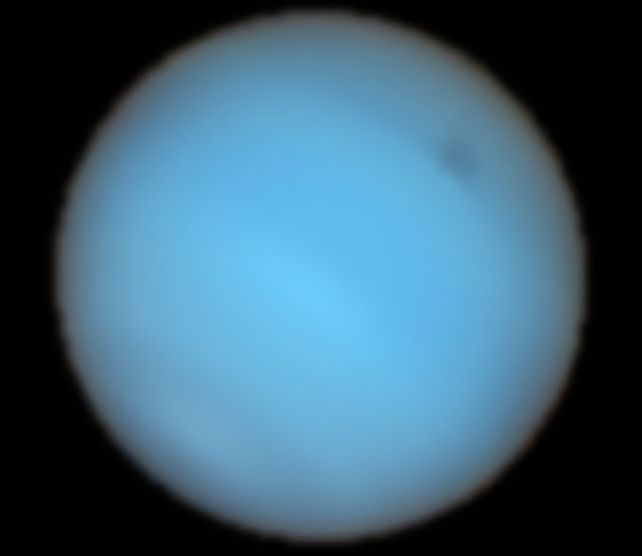Ever since Voyager 2 flew past Neptune in 1989, the giant dark smudges that appear in the distant planet's atmosphere have presented a strange puzzle.
Now, for the first time, we have observed one with Earth-based instruments in unprecedented resolution, helping scientists figure out why those patches appear so dark and why they are so different from spots on other planets.
"Since the first discovery of a dark spot, I've always wondered what these short-lived and elusive dark features are," says astronomer Patrick Irwin of the University of Oxford in the UK.
"I'm absolutely thrilled to have been able to not only make the first detection of a dark spot from the ground, but also record for the very first time a reflection spectrum of such a feature."
Neptune's dark vortices are actually anticyclonic storms, like the Great Red Spot on Jupiter, but they differ in several key, and mysterious, ways. For one thing, they are comparatively short-lived, appearing and dissipating every few years.

They are also thought to be relatively devoid of cloud in their centers, compared to storm vortices on Saturn and Jupiter. The clouds we can detect are fluffy white clouds that appear around the edges, probably as a result of gasses freezing into methane ice crystals as they are lifted up from lower altitudes.
But learning anything more has been challenging due to Neptune's distance and the short-lived nature of the vortices. Since 1994, the Hubble Space Telescope has been the only instrument capable of observing and tracking them, which limits the range of wavelengths in which the planet can be seen.
When a large storm vortex appeared in 2018, however, Irwin and his team got to work with another instrument: the Very Large Telescope's Multi Unit Spectroscopic Explorer (MUSE). MUSE was able to detect the sunlight reflecting off Neptune, and split it into its constituent wavelengths to reconstruct a 3D spectrum of the planet.

Different wavelengths are associated with different altitudes in Neptune's atmosphere, so the researchers were able to work out the altitude of the dark spot. And they found something surprising: it didn't appear to be a "hole" in Neptune's atmosphere after all.
Rather, the deeper color seems to be the result of a darkening of particles in the layer of hydrogen sulfide that sits below the top layer of Neptune's atmospheric aerosol haze. This, the researchers believe, could be the result of local heating in the deep part of an anticyclonic vortex, which vaporizes the hydrogen sulfide ice to reveal a darker vortex core. The researcher's observations are consistent with the particles in the aerosol layer above becoming smaller, reducing opacity.
They found another surprise, too: a bright cloud accompanying the vortex. This was not one of the methane clouds often found accompanying Neptune vortices, but a type of cloud never seen before. Rather than sitting higher in the atmosphere, it seemed to be at the same altitude as the dark vortex.
What this is, and whether any of the team's proposed mechanisms for Neptune's atmospheric darkening are correct, will need to be investigated further. But, with ground-based observations of Neptune now possible, we seem to be much closer to answers.
"This is an astounding increase in humanity's ability to observe the cosmos," says astronomer Michael Wong of the University of California, Berkeley.
"At first, we could only detect these spots by sending a spacecraft there, like Voyager. Then we gained the ability to make them out remotely with Hubble. Finally, technology has advanced to enable this from the ground."
The research has been published with Nature Astronomy.
